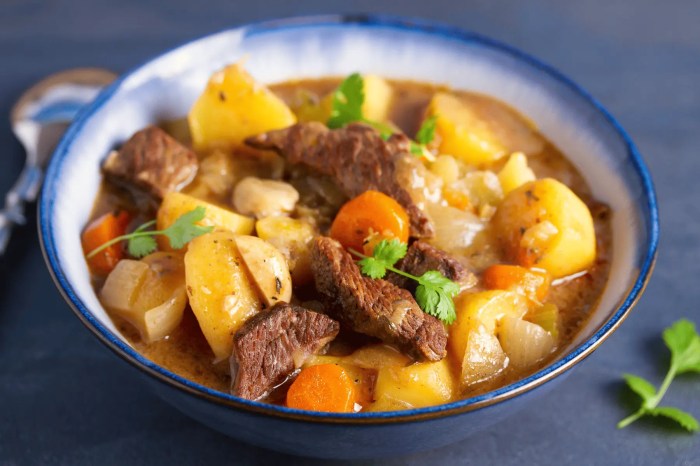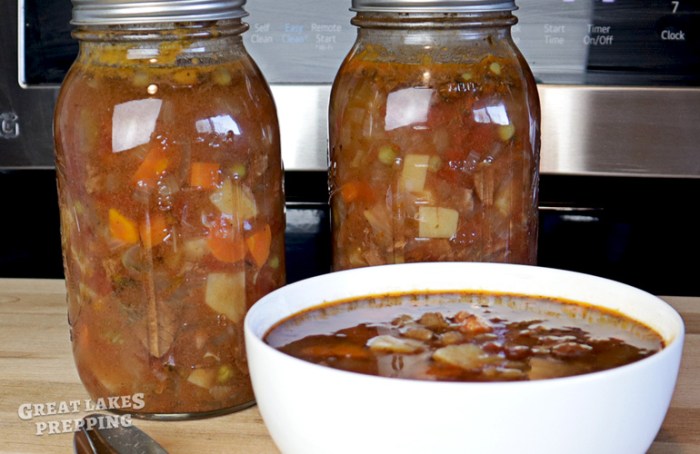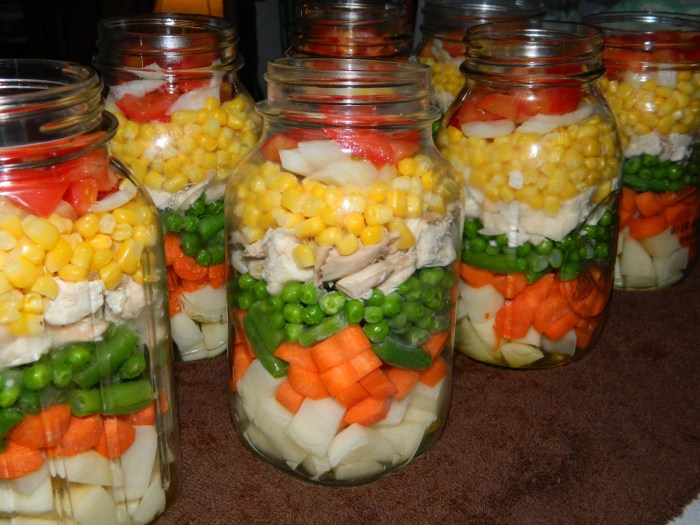Vegetable Beef Soup Canning Recipe Variations
This section explores three variations of our vegetable beef soup canning recipe, each highlighting a unique vegetable profile to cater to different tastes and preferences. The variations focus on hearty root vegetables, summer squash, and leafy greens, showcasing the versatility of this classic soup.
Hearty Root Vegetable Variation
This variation emphasizes the earthy sweetness and robust texture of root vegetables. It offers a richer, more substantial soup ideal for colder months.
- Beef: 2 lbs, cubed
- Carrots: 2 cups, diced
- Potatoes: 2 cups, diced
- Rutabagas: 1 cup, diced
- Turnips: 1 cup, diced
- Celery: 1 cup, diced
- Onion: 1 large, chopped
- Beef broth: 6 cups
- Seasoning: Salt, pepper, bay leaf, thyme
The flavor profile is rich and savory, with a slightly sweet undertone from the root vegetables. The texture is hearty and substantial, thanks to the dense root vegetables.
Summer Squash Variation
This variation utilizes the delicate flavors and tender texture of summer squash, creating a lighter, brighter soup perfect for warmer weather.
- Beef: 1.5 lbs, cubed
- Yellow squash: 2 cups, diced
- Zucchini: 2 cups, diced
- Bell peppers (various colors): 1 cup, diced
- Corn: 1 cup, kernels
- Onion: 1 medium, chopped
- Vegetable broth: 6 cups
- Seasoning: Salt, pepper, oregano, basil
The flavor profile is lighter and more refreshing, with a hint of sweetness from the squash and corn. The texture is tender and less substantial than the root vegetable variation.
Leafy Green Variation

Source: awesomecookingideas.com
This variation incorporates the nutritional benefits and vibrant flavor of leafy greens, resulting in a hearty and healthy soup option.
- Beef: 1.5 lbs, cubed
- Kale: 2 cups, chopped
- Spinach: 2 cups, chopped
- Green beans: 1 cup, trimmed and halved
- Celery: 1 cup, diced
- Onion: 1 medium, chopped
- Beef broth: 6 cups
- Seasoning: Salt, pepper, garlic powder, parsley
This variation provides a more savory and slightly bitter flavor profile from the leafy greens. The texture is a balance of tender beef and slightly firmer greens.
Canning Process & Safety
Proper canning techniques are crucial for ensuring food safety and preserving the quality of your vegetable beef soup. The following steps Artikel a safe and effective canning process.
| Step Number | Procedure | Safety Precautions | Time Estimate |
|---|---|---|---|
| 1 | Prepare ingredients: Wash, chop, and dice all vegetables. Cube beef. | Wash hands thoroughly. Sanitize all equipment. | 30 minutes |
| 2 | Cook beef and vegetables: Simmer beef until tender, then add vegetables and continue cooking until tender. | Ensure beef is fully cooked to a safe internal temperature. | 1-1.5 hours |
| 3 | Fill jars: Ladle hot soup into clean, sterilized jars, leaving headspace. | Leave appropriate headspace to prevent jars from breaking during processing. | 15 minutes |
| 4 | Process in pressure canner: Process according to recommended time and pressure for your altitude. | Follow manufacturer’s instructions for your specific pressure canner. | 75-90 minutes (varies by altitude) |
| 5 | Cool and check seals: Allow jars to cool completely. Check seals to ensure proper sealing. | Do not disturb jars during cooling. | 12-24 hours |
Pressure Canner Illustration
The illustration would depict a pressure canner with labeled parts: the lid, pressure gauge, vent pipe, and locking mechanism. Arrows would indicate the correct sequence of locking the lid, venting steam, and achieving the proper pressure. A second image would showcase the correct way to remove jars from the canner after processing, emphasizing caution to prevent burns.
Ingredient Sourcing & Preparation
Using high-quality ingredients is paramount for both the flavor and safety of your canned vegetable beef soup. This section offers guidance on selecting and preparing ingredients for optimal results.
Ingredient Selection and Preparation
Select fresh, high-quality beef with minimal fat. Choose vegetables that are firm, vibrant in color, and free from blemishes. Proper preparation involves washing all ingredients thoroughly, then chopping or dicing them to a consistent size for even cooking.
- Beef: Choose lean cuts like chuck or round, and trim excess fat.
- Vegetables: Select vegetables that are in season for the best flavor and nutritional value.
- Chopping Techniques: Dice vegetables into uniform sizes for even cooking and appealing presentation.
Recipe Scaling & Storage

Source: greatlakescountry.com
This section explains how to adjust the recipe for different jar sizes and provides guidelines for proper labeling and storage of your canned soup.
Recipe Scaling and Storage
The recipe can be easily scaled up or down by maintaining the ratio of ingredients. For example, doubling the recipe will yield twice the amount of soup, suitable for larger jars. Proper labeling includes the date of canning, a list of ingredients, and storage instructions. Store canned soup in a cool, dark, and dry place.
Label Template Description, Vegetable beef soup canning recipe
The label template would include sections for: “Vegetable Beef Soup,” the canning date, a list of ingredients (including any added spices), storage instructions (“Store in a cool, dark place. Best consumed within 12-18 months.”), and any allergy warnings.
Troubleshooting Common Issues: Vegetable Beef Soup Canning Recipe
This section addresses common problems encountered during the canning process and provides solutions to prevent spoilage and ensure safe consumption.
Troubleshooting
- Problem: Improper sealing. Cause: Insufficient headspace, jar defects, or improper processing. Solution: Ensure correct headspace, use undamaged jars, and follow processing times precisely.
- Problem: Spoilage. Cause: Inadequate processing, contaminated equipment, or improper storage. Solution: Follow canning procedures meticulously, sanitize equipment thoroughly, and store in a cool, dark place.
- Problem: Jars breaking during processing. Cause: Overfilling jars, sudden temperature changes, or using damaged jars. Solution: Maintain correct headspace, avoid rapid temperature changes, and use undamaged jars.
Nutritional Information & Serving Suggestions
This section provides nutritional information and creative serving suggestions to enhance the enjoyment and nutritional value of your canned vegetable beef soup.
Nutritional Information and Serving Suggestions
Nutritional information will vary depending on the specific recipe variation and ingredients used. A general estimate per serving (assuming a standard recipe) might include approximately 250-300 calories, 20-25g protein, and a significant amount of vitamins and minerals from the vegetables. Serving suggestions include using the soup as a base for other dishes (e.g., adding pasta, dumplings, or noodles), or serving it with crusty bread, a side salad, or grilled cheese.
Adding extra ingredients like lentils, quinoa, or additional vegetables can enhance the nutritional value and flavor complexity.
Equipment & Supplies

Source: thehomesteadsurvival.com
Having the right equipment and supplies is essential for a successful and safe canning process. The following list Artikels the necessary items.
Equipment and Supplies
- Pressure canner: For safe processing of low-acid foods.
- Canning jars and lids: Sterilizable jars with appropriate seals.
- Jar lifter: For safely handling hot jars.
- Large stockpot: For cooking the soup.
- Ladle: For transferring soup into jars.
- Magnetic lid lifter: For easy handling of lids.
- Funnel: To prevent spills when filling jars.
- Measuring cups and spoons: For accurate ingredient measurements.
- Cutting board and knives: For preparing ingredients.
Commonly Asked Questions
What type of beef is best for canning?
Stewing beef or chuck roast are ideal choices due to their high connective tissue, which breaks down beautifully during the long cooking time, resulting in a tender and flavorful soup.
Creating a delicious vegetable beef soup for canning requires careful attention to detail, ensuring proper sterilization and processing times. For a richer broth, consider exploring alternative options like those found in excellent turkey stock soup recipes , which could easily adapt to a beef-based version. Ultimately, the best vegetable beef soup canning recipe is the one that best suits your taste and canning experience.
Can I use frozen vegetables?
While fresh vegetables are preferred for optimal flavor and texture, you can use frozen vegetables. Ensure they are thoroughly thawed and drained before adding them to the soup to prevent excess liquid.
How long will canned vegetable beef soup last?
Properly canned vegetable beef soup, stored in a cool, dark place, will typically last for 12-18 months.
What if my jars don’t seal properly?
If jars don’t seal, check for any debris on the jar rims or lid, ensure proper headspace, and verify the pressure canner reached the correct pressure and time. Unsealed jars should be refrigerated and consumed within a few days.
